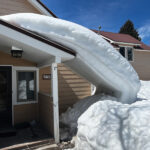Metal fasteners are expected to last and be the glue that holds structures and their components together. However, corrosion can adversely change all that. Corrosion happens when metal’s inherent properties begin to degrade. This weakens metal fasteners and could lead to compromised structural integrity.
How metal fastener corrosion happens and how to prevent it

Corrosion happens when metal’s inherent properties begin to degrade. (Photo courtesy of Triangle Fasteners)
“The impact of corrosion on metal fasteners can be wide ranging,” says Joe Stager, vice president of product development, marketing and sales at Triangle Fastener Corp., Pittsburgh. “In minor but still undesirable cases, corrosion can be an aesthetic problem. A fastener itself could discolor or it could stain the area around it. In severe cases, corrosion can cause significant reduction in the strength of the fastener, which could lead to a break or failure.”
GALVANIC CORROSION
All metals, including metal used in fasteners, have a specific electrical potential, and different metals (steel and copper, for example) have different types of electric potential. To ensure a metal fastener’s integrity and strength, correct metals must be in contact with each other. Galvanic corrosion is an adverse chemical reaction that happens when dissimilar metals with different potentials make contact. It’s an electrical process in which a galvanic cell is created and low-energy electric current flows between the two metals.

Galvanic corrosion between a galvanized steel roof panel and a stainless steel cap head fastener. (Photo courtesy of Triangle Fastener Corp.)
“There is an exchange of electrons that takes place between the two metals as electrons flow from the metal with greater negative potential (the anode) to the metal with lesser negative potential (the cathode), therefore the anode corrodes as the galvanic reaction takes place,” says Peter R. Graves, PE, vice president of engineering and technical services, ST Fastening Systems, Tyler, Texas. A galvanic scale rates all metals based on their resistance or tendency to corrosion. Each metal has been measured and rated for its nobility, or its resistance to corrosion, especially when one metal contacts another. “The farther the metals are away from each other on the galvanic series chart, the higher the electronic reaction between the metals, and the greater the rate of corrosion,” Graves adds.
Mismatched metals don’t even need to be in direct contact with each other for corrosion to occur. It can happen when they are connected by a conductive electrolyte, such as groundwater, rainwater running from one surface to another or via slightly acidic moisture. Galvanic corrosion will not take place in dry, arid conditions, but it will always be a problem in wet and humid conditions. The severity of corrosion depends on the type and amount of moisture. The potential for corrosion is greater near areas where salt is used for snow removal and also in coastal environments. “The salt content in the moisture increases the propensity for galvanic reaction to occur,” Graves says. “In coastal regions with very high humidity, or other harsh environments, galvanic metal pairs should be limited to those with a potential difference no greater than 0.15 volts. In moderate environments, metal pairs should have a potential difference no greater than 0.25 volts.”

This Florida roof, in very close proximity to the ocean, shows corrosion of its aluminum panel and zinc cap head carbon steel fastener. (Photo courtesy of Triangle Fastener Corp.)

This Florida roof, in very close proximity to the ocean, shows corrosion of its aluminum panel and zinc cap head carbon steel fastener. (Photo courtesy of Triangle Fastener Corp.)
Stager cautions that corrosion can also occur from acid rain’s sulfur dioxide and nitrogen oxides, chlorine-based chemicals (especially in enclosed pool areas) and preservative-treated lumber with high copper content. “Copper is very far from zinc on the galvanic chart and the zinc sacrifices itself to the copper relatively quickly,” Graves explains.
PREVENTING CORROSION
Besides being aware of dissimilar metals and potentially corrosive environments, there are other steps to take to prevent metal fastener corrosion. “Plating, paint and other coatings can help to reduce the speed and severity of corrosion by creating a barrier between the metal fastener and its environment,” Stager says. “If you can successfully separate the metal from oxygen, moisture and other environmental factors, you can stop corrosion.”

Kesternich testing is an accelerated corrosion indicator for fasteners. (Photo courtesy of ST Fastening Systems)
Insulative coatings can prevent leaching, residue and rust, but only so far as the coatings will last. [Also], “The type and thickness of a coating on a fastener influences the ability for air and moisture from getting to the steel below,” Graves says. “The most common form is an electroplated galvanizing process, which completely covers the steel wire. As the zinc sacrifices itself to protect the steel, this coating is eaten away. The thicker it is, the longer it lasts. A paint or powder coating on top of the electroplated zinc helps extend this process and increases the protection of the zinc.”
Poor installation techniques such as over-tightening, and scratching or chipping the surface can compromise the coating and reduce the life of the fastener. “The evolution of screw guns for lighter and faster impact drivers has exacerbated this problem,” Graves says. “They are faster and stronger, and beat the screw in with a rotational impacting action that causes microscopic cracking of the surface and zinc undercoating. This creates hidden problems that may not be visible on the surface. If the screw is over-tightened and stripped out, the threads cannot build-up any resistance to backout or pullout forces. If the coating is breached or the substrate has moisture or treatments that attack and deteriorate the zinc coating, rust will occur as soon as the coating breaks down.”





